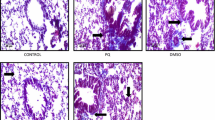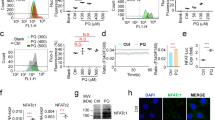Abstract
Paraquat (PQ), a widely used potent herbicide, generates superoxide anions and other free radicals, leading to severe toxicity and acute lung injury. PQ induces pulmonary fibrosis through epithelial to mesenchymal transition (EMT) characterized by increased number of myofibroblasts. Time-dependent PQ-induced EMT has been evaluated in present investigation where intracellular ROS levels were significantly enhanced after 24 h of PQ intoxication. Anti-inflammatory effects of curcumin have been studied where alveolar epithelial cells (A549 cells) were incubated with curcumin (30 μΜ) for 1 and 3 h before PQ intoxication (700 μM). Western blot and immunocytochemistry studies revealed that pretreatment of A549 cells with curcumin for 3 h before PQ exposure has maintained E-cadherin expression and inhibited PQ induced α-smooth-muscle actin (α-SMA) expression. Transforming growth factor-β (TGF-β) that seems to be involved in PQ-induced EMT was enhanced after PQ intoxication, but curcumin pretreatment has effectively inhibited its expression. Immunostaining studies have shown that curcumin pretreatment has significantly reduced matrix metalloproteinase-9 (MMP-9) expressions, which were elevated after PQ intoxication. These results demonstrate that curcumin can regulate PQ-induced EMT by regulating the expression of TGF-β.













Similar content being viewed by others
References
Eddleston, M. 2000. Patterns and problems of deliberate self-poisoning in the developing world. QJM 93: 715–731.
Sittipunt, C. 2005. Paraquat poisoning. Respiratory Care 50 (3): 383–385.
Bismuth, C., R. Garnier, F.J. Band, J. Muszynski, and C. Keyes. 1990. Paraquat poisoning. An overview of the current status. Drug Safety 5 (4): 243–251.
Dinis-Oliveira, R.J., J.A. Duarte, A. Sanchez-Navarro, F. Remiao, M.L. Bastos, and F. Carvalho. 2008. Paraquat poisonings: Mechanisms of lung toxicity, clinical features and treatment. Critical Reviews in Toxicology 38 (1): 13–71.
Zerin, T., Y.S. Kim, S.Y. Hong, and H.Y. Song. 2012. Protective effect of methylprednisolone on paraquat-induced A549 cell cytotoxicity via induction of efflux transporter, P-glycoprotein expression. Toxicology Letters 208 (2): 101–107.
Knight, D.A., and S.T. Holgate. 2003. The airway epithelium: Structural and functional properties in health and disease. Respirology 8 (4): 432–446.
Chuquimia, O.D., D.H. Petursdottir, N. Periolo, and C. Fernández. 2013. Alveolar epithelial cells are critical in protection of the respiratory tract by secretion of factors able to modulate the activity of pulmonary macrophages and directly control bacterial growth. Infection and Immunity 81 (1): 381–389.
Hiemstra, P.S., P.B. McCray, and R. Bals. 2015. The innate immune function of airway epithelial cells in inflammatory lung disease. European Respiratory Journal 45 (4): 1150–1162.
Bals, R., and P.S. Hiemstra. 2004 Feb. Innate immunity in the lung: How epithelial cells fight against respiratory pathogens. The European Respiratory Journal 23 (2): 327–333.
Parker, D., and A. Prince. 2011 Aug 1. Innate immunity in the respiratory epithelium. American Journal of Respiratory Cell and Molecular Biology 45 (2): 189–201.
Williams, M.C. 2003. Alveolar type I cells: Molecular phenotype and development. Annual Review of Physiology 65 (1): 669–695.
Fereol, S., R. Fodil, G. Pelle, B. Louis, and D. Isabey. 2008. Cell mechanics of alveolar epithelial cells (AECs) and macrophages (AMs). Respiratory Physiology & Neurobiology 163 (1): 3–16.
Castranova, V., J. Rabovsky, J.H. Tucker, and P.R. Miles. 1988. The alveolar type II epithelial cell: A multifunctional pneumocyte. Toxicology and Applied Pharmacology 93 (3): 472–483.
Evans, M.J., L.J. Cabral, R.J. Stephens, and G. Freeman. 1973. Renewal of alveolar epithelium in the rat following exposure to NO2. The American Journal of Pathology 70 (2): 175–198.
Crosby, L.M., and C.M. Waters. 2010. Epithelial repair mechanisms in the lung. American Journal of Physiology. Lung Cellular and Molecular Physiology 298 (6): L715–L731.
Sakai, N., and A.M. Tager. 2013. Fibrosis of two: Epithelial cell-fibroblast interactions in pulmonary fibrosis. Biochimica et Biophysica Acta (BBA) - Molecular Basis of Disease 1832 (7): 911–921.
Schissel SL, Layne MD 2006. Telomerase, myofibroblasts, and pulmonary fibrosis. 520–522.
Kage, H., and Z. Borok. 2012. EMT and interstitial lung disease: A mysterious relationship. Current Opinion in Pulmonary Medicine 18 (5): 517–523.
Lamouille, S., J. Xu, and R. Derynck. 2014. Molecular mechanisms of epithelial–mesenchymal transition. Nature Reviews Molecular Cell Biology 15 (3): 178–196.
Kalluri, R., and R.A. Weinberg. 2009. The basics of epithelial-mesenchymal transition. The Journal of Clinical Investigation 119 (6): 1420–1428.
Kalluri, R., and E.G. Neilson. 2003. Epithelial-mesenchymal transition and its implications for fibrosis. Journal of Clinical Investigation 112 (12): 1776–1784.
Kim, K.K., M.C. Kugler, P.J. Wolters, L. Robillard, M.G. Galvez, A.N. Brumwell, D. Sheppard, and H.A. Chapman. 2006. Alveolar epithelial cell mesenchymal transition develops in vivo during pulmonary fibrosis and is regulated by the extracellular matrix. Proceedings of the National Academy of Sciences 103 (35): 13180–13185.
Tanjore, H., X.C. Xu, V.V. Polosukhin, A.L. Degryse, B. Li, W. Han, T.P. Sherrill, D. Plieth, E.G. Neilson, T.S. Blackwell, and W.E. Lawson. 2009. Contribution of epithelial-derived fibroblasts to bleomycin-induced lung fibrosis. American Journal of Respiratory and Critical Care Medicine 180 (7): 657–665.
Yamada, A., T. Aki, K. Unuma, T. Funakoshi, K. Uemura, et al. 2015. Paraquat induces epithelial-mesenchymal transition-like cellular response resulting in fibrogenesis and the prevention of apoptosis in human pulmonary epithelial cells. PLoS One 10 (3): e0120192.
Han, Y.Y., P. Shen, and W.X. Chang. 2015. Involvement of epithelial-to-mesenchymal transition and associated transforming growth factor-β/Smad signaling in paraquat-induced pulmonary fibrosis. Molecular Medicine Reports 12 (6): 7979–7984.
Tyagi, N., D. Dash, and R. Singh. 2016. Curcumin inhibits paraquat induced lung inflammation and fibrosis by extracellular matrix modifications in mouse model. Inflammopharmacology. 24 (6): 335–345.
Xu, S., B. Jiang, H. Wang, C. Shen, H. Chen, and L. Zeng. 2017. Curcumin suppresses intestinal fibrosis by inhibition of pparγ-mediated epithelial-mesenchymal transition. Evidence-based Complementary and Alternative Medicine. https://doi.org/10.1155/2017/7876064.
Wang Q, Qu C, Xie F, Chen L, Liu L, Liang X. Curcumin suppresses epithelial-to-mesenchymal transition and metastasis of pancreatic cancer cells by inhibiting cancer-associated fibroblasts. American Journal of Cancer Research 017;7(1):125.
Mosmann, T. 1983. Rapid colorimetric assay for cellular growth and survival: Application to proliferation and cytotoxicity assays. Journal of Immunological Methods 65 (1–2): 55–63.
Alaimo, A., R.M. Gorojod, and M.L. Kotler. 2011. The extrinsic and intrinsic apoptotic pathways are involved in manganese toxicity in rat astrocytoma C6 cells. Neurochemistry International 59 (2): 297–308.
Brussel, J.P., G.J. van Steenbrugge, J.C. Romijn, F.H. Schröder, and G.H.J. Mickisch. 1999. Chemosensitivity of prostate cancer cell lines and expression of multidrug resistance-related proteins. European Journal of Cancer 35 (4): 664–671.
Giulietti, A., L. Overbergh, D. Valckx, B. Decallonne, R. Bouillon, and C. Mathieu. 2001. An overview of real-time quantitative PCR: Applications to quantify cytokine gene expression. Methods 25 (4): 386–401.
Willis, B.C., R.M. Dubois, and Z. Borok. 2006. Epithelial origin of myofibroblasts during fibrosis in the lung. Proceedings of the American Thoracic Society 3 (4): 377–382.
Wu, T., J.M. Chen, T.G. Xiao, X.B. Shu, H.C. Xu, L.L. Yang, L.J. Xing, P.Y. Zheng, and G. Ji. 2016. Qinggan Huoxue recipe suppresses epithelial-to-mesenchymal transition in alcoholic liver fibrosis through TGF-β1/Smad signaling pathway. World Journal of Gastroenterology 22 (19): 4695–4706.
Sheppard, D. 2006. Transforming growth factor β: A central modulator of pulmonary and airway inflammation and fibrosis. Proceedings of the American Thoracic Society 3 (5): 413–417.
Kasai, H., J.T. Allen, R.M. Mason, T. Kamimura, and Z. Zhang. 2005. TGF-β1 induces human alveolar epithelial to mesenchymal cell transition (EMT). Respiratory Research 6 (1): 56.
Hay, E.D. 1995. An overview of epithelio-mesenchymal transformation. Cells, Tissues, Organs 154 (1): 8–20.
Willis, B.C., and Z. Borok. 2007. TGF-β-induced EMT: Mechanisms and implications for fibrotic lung disease. American Journal of Physiology Lung Cellular and Molecular Physiology 293 (3): L525–L534.
Funding
The authors are thankful to DST-Science and Engineering Research Board (DST-SERB), New Delhi, India for financial assistance.
Author information
Authors and Affiliations
Corresponding author
Ethics declarations
Conflict of Interest
The authors declare that they have no conflict of interest.
Additional information
Publisher’s Note
Springer Nature remains neutral with regard to jurisdictional claims in published maps and institutional affiliations.
Rights and permissions
About this article
Cite this article
Tyagi, N., Singh, D.K., Dash, D. et al. Curcumin Modulates Paraquat-Induced Epithelial to Mesenchymal Transition by Regulating Transforming Growth Factor-β (TGF-β) in A549 Cells. Inflammation 42, 1441–1455 (2019). https://doi.org/10.1007/s10753-019-01006-0
Published:
Issue Date:
DOI: https://doi.org/10.1007/s10753-019-01006-0




